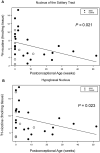The effect of maternal smoking and drinking during pregnancy upon (3)H-nicotine receptor brainstem binding in infants dying of the sudden infant death syndrome: initial observations in a high risk population
- PMID: 17924983
- PMCID: PMC8095492
- DOI: 10.1111/j.1750-3639.2007.00093.x
The effect of maternal smoking and drinking during pregnancy upon (3)H-nicotine receptor brainstem binding in infants dying of the sudden infant death syndrome: initial observations in a high risk population
Abstract
The high rate of the sudden infant death syndrome (SIDS) in American Indians in the Northern Plains (3.5/1000) may reflect the high incidence of cigarette smoking and alcohol consumption during pregnancy. Nicotine, a neurotoxic component of cigarettes, and alcohol adversely affect nicotinic receptor binding and subsequent cholinergic development in animals. We measured (3)H-nicotine receptor binding in 16 brainstem nuclei in American Indian SIDS (n = 27) and controls (n = 6). In five nuclei related to cardiorespiratory control, (3)H-nicotinic binding decreased with increasing number of drinks (P < 0.03). There were no differences in binding in SIDS compared with controls, except upon stratification of prenatal exposures. In three mesopontine nuclei critical for arousal there were reductions (P < 0.04) in binding in controls exposed to cigarette smoke compared with controls without exposure; there was no difference between SIDS cases with or without exposure. This study suggests that maternal smoking and alcohol affects (3)H-nicotinic binding in the infant brainstem irrespective of the cause of death. It also suggests that SIDS cases are unable to respond to maternal smoking with the "normal" reduction seen in controls. Future studies are needed to establish the role of adverse prenatal exposures in altered brainstem neurochemistry in SIDS.
Figures




Similar articles
-
Serotonergic brainstem abnormalities in Northern Plains Indians with the sudden infant death syndrome.J Neuropathol Exp Neurol. 2003 Nov;62(11):1178-91. doi: 10.1093/jnen/62.11.1178. J Neuropathol Exp Neurol. 2003. PMID: 14656075
-
Brainstem 3H-nicotine receptor binding in the sudden infant death syndrome.J Neuropathol Exp Neurol. 1998 Nov;57(11):1018-25. doi: 10.1097/00005072-199811000-00004. J Neuropathol Exp Neurol. 1998. PMID: 9825938
-
Early developmental changes in [3H]nicotine binding in the human brainstem.Neuroscience. 1993 Aug;55(4):1127-38. doi: 10.1016/0306-4522(93)90326-b. Neuroscience. 1993. PMID: 8232902
-
Brainstem mechanisms underlying the sudden infant death syndrome: evidence from human pathologic studies.Dev Psychobiol. 2009 Apr;51(3):223-33. doi: 10.1002/dev.20367. Dev Psychobiol. 2009. PMID: 19235901 Review.
-
The triple risk hypotheses in sudden infant death syndrome.Pediatrics. 2002 Nov;110(5):e64. doi: 10.1542/peds.110.5.e64. Pediatrics. 2002. PMID: 12415070 Review.
Cited by
-
Prenatal alcohol exposure and miscarriage, stillbirth, preterm delivery, and sudden infant death syndrome.Alcohol Res Health. 2011;34(1):86-91. Alcohol Res Health. 2011. PMID: 23580045 Free PMC article. Review.
-
Perinatal Nicotine Reduces Chemosensitivity of Medullary 5-HT Neurons after Maturation in Culture.Neuroscience. 2020 Oct 15;446:80-93. doi: 10.1016/j.neuroscience.2020.08.012. Epub 2020 Aug 17. Neuroscience. 2020. PMID: 32818601 Free PMC article.
-
Concurrent prenatal drinking and smoking increases risk for SIDS: Safe Passage Study report.EClinicalMedicine. 2020 Jan 20;19:100247. doi: 10.1016/j.eclinm.2019.100247. eCollection 2020 Feb. EClinicalMedicine. 2020. PMID: 32140668 Free PMC article.
-
The brainstem and serotonin in the sudden infant death syndrome.Annu Rev Pathol. 2009;4:517-50. doi: 10.1146/annurev.pathol.4.110807.092322. Annu Rev Pathol. 2009. PMID: 19400695 Free PMC article. Review.
-
Cardiac muscarinic receptor overexpression in sudden infant death syndrome.PLoS One. 2010 Mar 1;5(3):e9464. doi: 10.1371/journal.pone.0009464. PLoS One. 2010. PMID: 20209124 Free PMC article.
References
-
- Indian Health Service (1998) Regional Differences in Indian Health 1997. US Department of Health and Human Services, Public Health Service, Indian Health Service: Rockville, MD.
-
- Indian Health Service (2000) Regional Differences in Indian Health 1998–1999. Indian Health Service: Rockville, MD.
-
- Aston‐Jones G, Rajkowski J, Cohen J (1999) Role of locus coeruleus in attention and behavioral flexibility. Biol Psychiatry 46:1309–1320. - PubMed
-
- Benwell ME, Balfour DJ, Anderson JM (1988) Evidence that tobacco smoking increases the density of (‐)‐[3H]nicotine binding sites in human brain. J Neurochem 50:1243–1247. - PubMed
-
- Bouret S, Sara SJ (2005) Network reset: a simplified overarching theory of locus coeruleus noradrenaline function. Trends Neurosci 28:574–582. - PubMed
Publication types
MeSH terms
Substances
LinkOut - more resources
Full Text Sources
Medical

